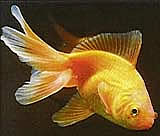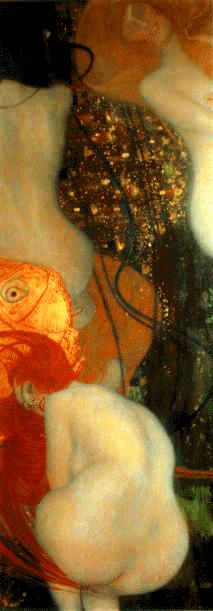Goldfish
|
|
| Goldfish Conservation status: Secure | ||||||||||||||||
|---|---|---|---|---|---|---|---|---|---|---|---|---|---|---|---|---|
 | ||||||||||||||||
| Scientific classification | ||||||||||||||||
| ||||||||||||||||
| Trinomial name | ||||||||||||||||
| Carassius auratus auratus (Linnaeus, 1758) |
For the Pepperidge Farm brand of snack crackers marketed in North America, see Goldfish (snack).
The goldfish (Carassius auratus) is one of the earliest fish to be domesticated, and is still one of the most commonly-kept aquarium fish. A relatively small member of the carp family (which also includes the koi and the Crucian carp), the goldfish is a domesticated version of a dark-gray carp native to East Asia (first domesticated in China) that was introduced to Europe in the late 17th century. It may grow to a maximum length of 23 inches (59.0 cm) and a maximum weight of 6.6 lb (3.0 kg), although this is rare: most individuals grow to under half this size.
Goldfish natively live in rivers, lakes, and other slow or still moving bodies of water in depths up to 20 m (65.6 ft. They natively live in a subtropical climate and prefer freshwater with a 6.0 - 8.0 pH, a water hardness of 5.0 - 19.0 dGH, and a temperature range of 32 to 106 °F (0 to 41 °C). Their diet consists of crustaceans, insects, and plant matter. They lay their eggs on aquatic vegetation. They quickly hatch into fry visible to the naked eye, often described as appearing like "an eyelash with two eyeballs". Within a week or so, they begin to look more like a goldfish in shape, although it can be as much as a year before they take their mature goldfish color. In those first weeks, they grow remarkably fast; an evolution borne of the high risk of getting devoured by the adult goldfish in their environment.
Part of its popularity is due to the goldfish's hardiness. Their supposed reputation in some areas for dying quickly is often due to poor care amongst uninformed buyers, especially children, looking for a "cheap" pet. The goldfish is a cold-water fish, and can live in an unheated aquarium or in an outdoor water garden. In a pond, it will even survive brief periods of ice forming on the surface, so long as there is enough oxygen remaining in the water and the pond does not freeze solid. It is important to remember that sudden changes in water temperature can be fatal to a goldfish; when transferring a store-bought goldfish to either a garden pond or an indoor tank, equalize the temperature in the transportation container by leaving it in the destination container for at least 20 minutes before releasing the goldfish. In addition, some temperature changes might simply be too great for even the hardy goldfish to adjust to. For example, buying a goldfish in a store, where the water might be 70 °F (approximately 21 °C), and hoping to release it into your garden pond at 40 °F (4 °C) will probably result in the death of the goldfish, even if you use the slow immersion method just described. A goldfish will need a lot more time, perhaps days or weeks, to adjust to such a different temperature.
Although edible, the fish is rarely eaten.
Selective breeding has produced several colour variations, some of them far removed from the "golden" colour of the original. There are also different body shapes, fin and eye configurations. Such extreme versions of the goldfish do need to be kept in an aquarium — they are much less hardy than varieties closer to the "wild" original.
Goldfish and other carp fishes are frequently added to stagnant ponds in order to reduce the mosquito populations, especially now with the arrival of West Nile Virus which relies on mosquitoes to migrate. Their introduction often has unfortunate consequences for local ecosystems, however.
GoldfishBowl_2004_SeanMcClean.jpg
Although goldfish were historically displayed in small "goldfish bowls", a healthy and happy goldfish requires at least 10 US gallons of water in order to live a full life. Each additional fish requires an additional five gallons (nearly 20 litres) of water. In fact, for single tailed varieties, such as commons or comets, it may even become necessary to have 20 to 50 US gallons (75 to 200 litres) per fish, depending on size. Other goldfish experts say that it is the amount of water surface area, not the water volume, that decides how many goldfish may live in a container; one square foot of water surface area for every inch of goldfish length. For example, if you had 3 goldfish of length 4 inches each, you might need 12 square feet of water surface area. Surface area is an approximate measure of how much oxygen may be absorbed into the water from the air. If the water is being further aerated by way of water pump or fountain, more goldfish may be kept in the container.
While it is true that goldfish can survive in a fairly wide temperature range, the optimal range for indoor fish is 68 to 78 °F (20 to 22 °C). Pet goldfish will usually eat more food that it needs if given, which can lead to a fatal intestinal blockage. They are omnivorous and do best with a wide variety of fresh vegetables and fruit to supplement a flake or pellet diet staple. Goldfish can only grow to sexual maturity if given enough water and the right nutrition. However if kept well, they may breed indoors. Breeding usually happens after a significant change in temperature, often in spring. Eggs should then be separated into another tank, as the parents will likely eat any of their young that they happen upon.
A fad among American college students for many years was swallowing goldfish as a stunt. The first recorded instance was in 1939 at Harvard University. The practice gradually fell out of popularity over the course of several decades.
In many countries, the operators of carnivals and fairs commonly give goldfish away in plastic bags as prizes for winning games. In the United Kingdom, the government proposed banning this practice as part of its Animal Welfare Bill, though early 2005 reports suggest that this idea has been dropped.
It is often said that goldfish have a memory span of only a few seconds, but this is not entirely true. Goldfish have what could be called a selective memory; that is to say, they have some kind of consciousness of what has happened on previous occasions, but may not be sure exactly what it was. They can learn to eat from a certain ring inside their tank, or even from their caretaker's hand, because they will remember that there is something good in that area, but might not remember what. If a predatory animal such as a heron is around, they will likely hide away for quite a while, but they probably do not know what it is they are hiding from; they simply know it is worth avoiding. Goldfish have a sense of time, and in captivity may be able to recognize a set feeding schedule, becoming excited before food even appears. Contrary to the notion that goldfish have poor memory, they will respond to a visit by a predator such as a raccoon, which may completely trash a small pond traumatizing the resident goldfish, by remaining extremely shy and jittery to any approach thereafter.
There is an urban legend that a pregnant goldfish is called a "twit" or "twat", but this was debunked by The Straight Dope.
Most goldfish can and will breed if left to themselves, in either aquariums or pond settings. Males chase the females around, bumping and nudging them in order to prompt the females to release her eggs, which the males then fertilize. In most aquariums, the parents tend to eat the eggs if they are not removed. Due to the strange shapes of modern bred goldfish, certain types can no longer breed among themselves. In these cases, a method of artificial breeding is used called "Hand stripping". This method keeps the breed going, but can be dangerous and harmful to the fish if not done correctly.
Goldfish varieties
- Black Moor
- Bubble Eye
- Celestial Eye
- Comet
- Fantail
- Lionhead
- Oranda
- Pearlscale
- Pompom
- Ryukin
- Shubunkin
- Telescope Eye
External links
- The Goldfish Connection (http://www.goldfishconnection.com) - The largest importer of high quality collector goldfish in the USA.
- The Goldfish Sanctuary (http://www.petlibrary.com/goldfish/goldfish.html) - Site of a now defunct goldfish rescue organization.
- Goldfish Paradise (http://www.goldfishparadise.com) - Site that contains tons of information on goldfish care.
- BBC News Online - Goldfish are no longer to be given as prizes (http://news.bbc.co.uk/1/hi/magazine/3893889.stm)
- BBC News Online - Ban on goldfish prizes 'dropped' (http://news.bbc.co.uk/1/hi/uk_politics/4174457.stm)
- Very handy FAQ - Good FAQ's (http://www.wetwebmedia.com/FWSubWebIndex/gldfshfdgfaqs.htm)
- The Straight Dope - Is a pregnant goldfish called a twit? (http://www.straightdope.com/columns/020329.html)
References
de:Goldfisch fr:Poisson rouge it:Carassius auratus he:דג זהב nl:Goudvis ja:キンギョ zh:金鱼

